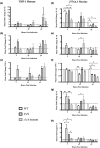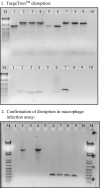A study of innate immune kinetics reveals a role for a chloride transporter in a virulent Francisella tularensis type B strain
- PMID: 33970545
- PMCID: PMC8483402
- DOI: 10.1002/mbo3.1170
A study of innate immune kinetics reveals a role for a chloride transporter in a virulent Francisella tularensis type B strain
Abstract
Tularemia is a zoonotic disease of global proportions. Francisella tularensis subspecies tularensis (type A) and holarctica (type B) cause disease in healthy humans, with type A infections resulting in higher mortality. Repeated passage of a type B strain in the mid-20th century generated the Live Vaccine Strain (LVS). LVS remains unlicensed, does not protect against high inhalational doses of type A, and its exact mechanisms of attenuation are poorly understood. Recent data suggest that live attenuated vaccines derived from type B may cross-protect against type A. However, there is a dearth of knowledge regarding virulent type B pathogenesis and its capacity to stimulate the host's innate immune response. We therefore sought to increase our understanding of virulent type B in vitro characteristics using strain OR96-0246 as a model. Adding to our knowledge of innate immune kinetics in macrophages following infection with virulent type B, we observed robust replication of strain OR96-0246 in murine and human macrophages, reduced expression of pro-inflammatory cytokine genes from "wild type" type B-infected macrophages compared to LVS, and delayed macrophage cell death suggesting that virulent type B may suppress macrophage activation. One disruption in LVS is in the gene encoding the chloride transporter ClcA. We investigated the role of ClcA in macrophage infection and observed a replication delay in a clcA mutant. Here, we propose its role in acid tolerance. A greater understanding of LVS attenuation may reveal new mechanisms of pathogenesis and inform strategies toward the development of an improved vaccine against tularemia.
Keywords: Francisella tularensis subsp. holarctica; Live Vaccine Strain; TargeTron™ chromosomal insertion; innate immunity; proton:chloride antiporter; tularemia.
© 2021 The Authors. MicrobiologyOpen published by John Wiley & Sons Ltd.
Conflict of interest statement
None declared.
Figures











Similar articles
-
A ΔclpB mutant of Francisella tularensis subspecies holarctica strain, FSC200, is a more effective live vaccine than F. tularensis LVS in a mouse respiratory challenge model of tularemia.PLoS One. 2013 Nov 13;8(11):e78671. doi: 10.1371/journal.pone.0078671. eCollection 2013. PLoS One. 2013. PMID: 24236032 Free PMC article.
-
Kdo hydrolase is required for Francisella tularensis virulence and evasion of TLR2-mediated innate immunity.mBio. 2013 Feb 12;4(1):e00638-12. doi: 10.1128/mBio.00638-12. mBio. 2013. PMID: 23404403 Free PMC article.
-
Live Attenuated Tularemia Vaccines for Protection Against Respiratory Challenge With Virulent F. tularensis subsp. tularensis.Front Cell Infect Microbiol. 2018 May 15;8:154. doi: 10.3389/fcimb.2018.00154. eCollection 2018. Front Cell Infect Microbiol. 2018. PMID: 29868510 Free PMC article. Review.
-
Interleukin-17 protects against the Francisella tularensis live vaccine strain but not against a virulent F. tularensis type A strain.Infect Immun. 2013 Sep;81(9):3099-105. doi: 10.1128/IAI.00203-13. Epub 2013 Jun 17. Infect Immun. 2013. PMID: 23774604 Free PMC article.
-
Vaccines against Francisella tularensis.Ann N Y Acad Sci. 2007 Jun;1105:325-50. doi: 10.1196/annals.1409.012. Epub 2007 Mar 29. Ann N Y Acad Sci. 2007. PMID: 17395730 Review.
Cited by
-
Ex vivo infection model for Francisella using human lung tissue.Front Cell Infect Microbiol. 2023 Jul 10;13:1224356. doi: 10.3389/fcimb.2023.1224356. eCollection 2023. Front Cell Infect Microbiol. 2023. PMID: 37492528 Free PMC article.
References
-
- Abu Kwaik, Y., & Bumann, D. (2013). Microbial quest for food in vivo: “Nutritional virulence” as an emerging paradigm. Cellular Microbiology, 15, 882–890. - PubMed
Publication types
MeSH terms
Substances
Associated data
Grants and funding
LinkOut - more resources
Full Text Sources
Other Literature Sources

